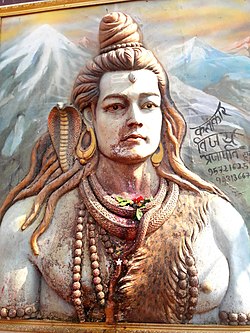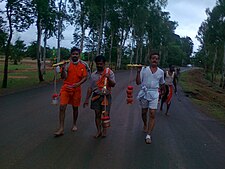Basukinath
This article needs additional citations for verification. (September 2020) |
Basukinath | |
|---|---|
city | |
| Coordinates: 24°23′N 87°05′E / 24.39°N 87.08°ECoordinates: 24°23′N 87°05′E / 24.39°N 87.08°E | |
| Country | |
| State | Jharkhand |
| District | Dumka |
| Population (2011) | |
| • Total | 17,123 |
| Languages | |
| • Official | Hindi, Urdu |
| Time zone | UTC+5:30 (IST) |
| Vehicle registration | JH |
| Website | dumka |
Basukinath is a city and notified area in the Dumka, Jharkhand, India.
Geography[edit]
| Cities, towns and locations in the Deoghar, Dumka and Jamtara districts in Santhal Pargana Division M: Municipality, CT: census town, R: Rural/ Urban centre, D: Dam, Owing to space constraints in the small map, the actual locations in a larger map may vary slightly |
Area[edit]
Basukinath has an area of 19.90 hectares (49.2 acres).[1]
Overview[edit]
The map shows a large area, which is a plateau with low hills, except in the eastern portion where the Rajmahal hills intrude into this area and the Ramgarh hills are there. The south-western portion is just a rolling upland. The entire area is overwhelmingly rural with only small pockets of urbanisation.[2]
Demographics[edit]
According to the 2011 Census of India, Basukinath had a total population of 17,123, of which 8,861 (52%) were males and 8,262 (48%) were females. Population in the age range 0–6 years was 2,701. The total number of literate persons in Basukinath was 14,422 (68.41% of the population over 6 years).[1]
As of the 2001[update] Indian census,[3] Basukinath has a population of 14,119 (52% men, 48% women). Basukinath has an average literacy rate of 54%, which is lower than the national average of 59.5%; with 62% of men and 38% of women literate. 17% of the population is under 6 years of age.
Infrastructure[edit]
According to the District Census Handbook 2011, Dumka, Basukinath covered an area of 17.23 km2. Among the civic amenities, it had 46 km roads with both open and closed drains, the protected water supply involved hand pump, uncovered well. It had 2,094 domestic electric connections, 300 road lighting points. Among the medical facilities, it had 3 hospitals, 2 dispensaries, 2 health centres, 1 family welfare centre, 1 maternity and child welfare centre, 1 nursing home, 4 charitable hospital/ nursing homes, 1 veterinary hospital, 20 medicine shops. Among the educational facilities it had 15 primary schools, 6 middle schools, 2 secondary schools, 2 senior secondary schools, 1 general degree college. It had 1 non-formal education centre (Sarba Shiksha Abhiyan). Among the social, cultural and recreational facilities it had 4 auditorium/ public halls, 1 public library, 1 reading room. Three important items it produced were sweets, iron goods, chira. It had the branch offices of 3 nationalised banks, 1 cooperative bank, 1 agricultural credit society.[4]
Religion[edit]
Basukinath serves as a place of pilgrimage for Hindus.[5] The Basukinath Temple is an attraction and situated along the Jasidih Dumka New Railway Line.[5]
Shravan mela[edit]
Basukinath is famous for the mela of Shraavana (a month of the Hindu calendar), between July and August. Some pilgrims are called "Bol Bam" when they pour holy water on the shivling after 4–5 days of journeying. The pilgrims en route to Basukinath also visit the Baidyanath Jyotirlinga in Deogarh.[6]
Ram Janki Vivah Utsav[edit]
Pandit Nainalal Jha and Pradhan Tirth Purohit Baba Basukinath started the festival of "Ram Janki Vivah Utsav" in Basukinath.[7] A baraat which included elephants and horses participated in the procession as well. In present day the festival has been continued by his son Pandit Tara Kant Jha.[citation needed]
References[edit]
- ↑ 1.0 1.1 "District Census Handbook, Dumka, Series 21, Part XII B" (PDF). Page 26: District Primary Census Abstract, 2011 census. Directorate of Census Operations Jharkhand. Retrieved 3 November 2020.
- ↑ Roychoudhury, P.C. "Bihar District Gazetteers: Santhal Parganas". Chapter I: General. Secretariat Press, Patna, 1965. Retrieved 10 November 2020.
- ↑ "Census of India 2001: Data from the 2001 Census, including cities, villages and towns (Provisional)". Census Commission of India. Archived from the original on 16 June 2004. Retrieved 1 November 2008.
- ↑ "District Census Handbook Dumka, Census of India 2011, Series 20, Part XII A" (PDF). 705-709. Directorate of census Operations, Jharkhand. Retrieved 8 November 2020.
- ↑ 5.0 5.1 "Basukinath is located in Dumka District of Jharkhand". Archived from the original on 7 October 2007. Retrieved 1 August 2007.
- ↑ "Month-long Shrawani Mela ends". The Times of India. 6 August 2009. Retrieved 6 April 2010.
- ↑ "Ram Janki Vivah Utsav at Basukinath Dham Deoghar | Explore Bihar". Retrieved 4 August 2020.



